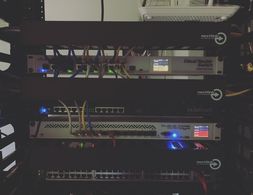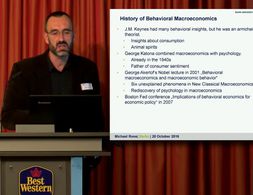Komplexitätsökonomik
Die Perspektiven der Pluralen Ökonomik
Perspektiven erkunden Perspektiven vergleichen
Dieser Text präsentiert eine Perspektive der Pluralen Ökonomik. Im Orientieren-Bereich kannst Du zehn verschiedene Perspektiven der Pluralen Ökonomik kennenlernen und vergleichen.
Author: Joeri Schasfoort | 18th September 2017
Deutsche Übersetzung folgt bald.
1. Core elements
Complexity economics is the study of economic systems as complex systems. Complex systems are systems which consist of interacting individuals that change their actions and strategies in response to the outcome they mutually create (Arthur 2013). Complexity economists study the emergence of structures and the unfolding of patterns in the economy and they regularly dispense with the assumptions of individual optimization and/or systemic equilibrium usually employed in the mainstream (Arthur 1999). Since the 2008 financial crisis, when mainstream equilibrium models had little to add in terms of policy direction (Armstrong 2017), there has been increasing interest in using ideas from complexity theory (Battiston et al 2016).
2. Terms, analysis, conception of economy
Complexity economists view the economy as a complex system which consists of, belongs to, and overlaps with other complex systems.
In this system, economic patterns such as economic growth and inflation are classified as emergent phenomena because they emerge out of the interactions of heterogeneous and adaptive agents with heterogeneous expectations (Kirman 2006, 2016). A broader definition of an emergent phenomenon is that it is a “new” pattern which arises as a result of the interactions of a number of elements between which simple relations exist but which cannot be reduced to the particular properties of each of these elements (Hayek 1964).
Complexity economists such as Arthur (2013) argue that non-equilibrium is the natural state of the economy. The economy is always in a state of flux, constantly evolving and changing. According to Arthur (2013), there are two main reasons for this. One is fundamental uncertainty, the other is technological innovation.
The concept of (fundamental) uncertainty was introduced in economics by Knight (1921) and Keynes (1921, 1936 and 1937). They felt a distinction should be made between risk and uncertainty. In the case of risk, all possible future events or consequences of an action or decision are known. Therefore, we can calculate the probability that this event will actually materialize. However, there are many situations in which we do not know all possible outcomes. In these situations of uncertainty, probability calculus has no sound foundation.
To deal with uncertainty, economic agents try to make sense of problems by surmising, making guesses, using past knowledge and experience (Arthur 2013), and using simple decision making heuristics (‚rules of thumb‘, Gigerenzer & Gaissmaier 2011). As a consequence, agents continually update their internal decision making model, which means they constantly adapt, discard and replace the actions or strategies based on their experience as they explore. Such dynamics are also known as ‘evolutionary dynamics’ (Lindgren 1997). Using evolutionary game theory, Lindgren (1997) demonstrates that evolutionary models usually do not end up in a stable Nash equilibrium in the presence of noise. If these results can be extrapolated to the broader economy, it should be permanently in disruptive motion as agents explore, learn, and adapt.
Technological innovation is the other important contributor to the economic system’s state of permanent flux. The nature of innovation is such that technological development enables further technological development (Arthur 2013). It follows that a novel technology is not just a one-time disruption to equilibrium. Instead, it is a permanent ongoing generator and demander of further technologies that themselves generate and demand still further technologies (Arthur, 2009). Thus, technological innovation also contributes to the state of flux, be it somewhat slower than uncertainty.
That being said, the state of flux is often relatively stable and can therefore be approximated by an equilibrium or steady state. But this equilibrium is often not unique: complex systems are regularly characterized by multiple equilibria, especially in the presence of positive feedback or increasing returns (Bosker et al. 2007).
The steady state a complex systems ends up with depends on the path towards that steady state. In other words, it is path-dependent. The resulting dynamics can take different forms: the system can approach a single equilibrium on a balanced path – the case often assumed in the economic mainstream – but there are oscillating or even chaotic dynamics, which play an essential role in complexity economics. In the latter case, tiny changes in initial conditions might cause the system to end up in a radically different steady state (Li and Yorke 1975).
Once a system ends up in a steady state, it might not be straightforward to move to another steady state. It might be so resilient to changes that it takes considerable shocks for it to move to another regime. This is also known as a ‘lock-in’ (Arthur 1989). On the other hand, if a system’s resilience is decreasing, it might reach a tipping point and suddenly change behavior or move to another regime (Battiston et al. 2016). Financial markets and economies have historically exhibited sudden and largely unforeseen collapses, at a systemic scale. Such phase transitions may in some cases have been triggered by unpredictable stochastic events. More often, there have been endogenous underlying processes at work (Battiston et al. 2016).
Summarizing, complexity economists view the economy as a complex system. Aggregate economic phenomena are viewed as patters emerging from the interactions between heterogeneous agents. While economic systems can be in relatively steady states which can be approximated by an equilibrium, the presence of uncertainty and technological innovation ensures that all economic system are in a constant state of flux. What is more, any relatively stable states which do emerge are often not unique, path dependent and, sometimes, even chaotic. On top of that, economic systems regularly go through phase transitions to end up in a different state. To adequately represent and study these dynamics, complexity economics uses tools and theories that is usually considered to be ‘broader’ as what is common in mainstream economics.
Es gibt noch so viel zu entdecken! 🚀
Im Entdecken-Bereich haben wir hunderte Videos, Texte und Podcasts zu ökonomischen Themen gesammelt. Außerdem kannst du selber Material vorschlagen!
Material entdecken Material vorschlagen
3. Ontology
The way that complexity economists perceive at the economy is similar the concept of systemism (Bunge 1996, Gräbner and Kapeller 2015) which states that a society is a layered system composed of changing subsystems and has global properties, both reducible and non-reducible, and with both upward effects (e.g. from individuals to social structures) and downward effects (e.g. from institutions on individuals) being relevant..
Complex economic systems overlap with other complex systems but not always in a hierarchical way. Rather, these overlapping systems can be described as a panarchy (Holling 2001) which refers to a structure in which systems are interlinked in continual adaptive cycles of growth, accumulation, restructuring, and renewal. Thus, complex systems have complex systems above and below them. At the same time, they are part of multiple overlapping complex systems.
Within a complex system, Dopfer et al (2004) identify three distinctive levels which drive its dynamics: the micro (individuals), meso (rules) and macro (system) levels. At each level, different types of decisions and interactions take place. The precise classification of what counts as the micro/meso/macro depends, of course, on the subject of investigation. For example, when discussing spatial economics, Commendatore et al. (2018) identify interactions among international or regional trading partners at the macro-level; markets as social network structures at the meso-level; and the strategic choices of single firms and households at the micro-level.
At the micro level, actors are viewed as boundedly rational (Simon 1972). This means that, their rationality is limited by the tractability of the decision problem, the cognitive limitations of the actor, and the time available to make the decision (Simon 1991). According to Arthur (2010), individuals generally do not optimize (e.g. utility). Rather, people engage in cognitive processes such as social comparison, imitation and repetitive behavior (habits) so as to efficiently use their limited cognitive resources (Jager et al. 2000; for a contribution from the viewpoint of psychology see Gigerenzer and Gaissmaier 2011).
At all three levels, time plays an important role, due to path-dependence. All states of economic systems rely on their past states. Viewed this way, the economy becomes a system that evolves procedurally in a series of events; it becomes algorithmic (Arthur 2013). Given the focus on the state of flux that a complex system is always in, understanding this continuous change can be said to be the central economic problem of complexity economics.
4. Epistemology
Among complexity economists, there is no consensus on how we can hope to understand our complex economic system, although the vast majority of them agrees that models are essential when studying complex systems. Moreover, one can identify two groups: a modest and an optimistic group. The modest group believes that their models can uncover causal mechanisms behind commonly observed economic patterns but that reality is too complex for these models to make very useful predictions about the economy. The optimistic group believes that on top of that their models can be used to make such predictions although these predictions will probably not be very exact. Below, I will first discuss the epistemology of the modest group and then that of the optimistic groups
The modest group argues that because the economy is so incredibly complex it is impossible to derive economic laws which are universally valid. Instead, complexity economists in this tradition should seek mechanism-based explanations (Gräbner 2017) and their models should be judged by their ability to uncover the mechanisms which produce common economic patterns.
The influence of the modest view is clear in Epstein’s (2006) vision of generative social sciences. In this vision, the role of the complexity economist is to generate processes of interest computationally. This is the only way for it to be understood: “If you grow it you show it.”
Similar to this, complexity economists influenced by the Austrian tradition, voice a deep skepticism about how much we can understand -let alone forecast about- the world and instead argue for modesty (Hoogduin 2016). Hayek (1964) gives three distinct reasons for this. First, the number of distinct variables required to explain a complex economic phenomena is often so large that it is practically (and perhaps even theoretically) impossible. Second, the overlapping of complex systems –tight coupling– can lead to unexpected interactions which were not anticipated by economic models. Finally, many complex systems show sensitivity on initial conditions which would make it very unlikely that are models are calibrated with the right initial conditions to produce useful forecasts.
In this way, economics (and other social sciences) are different from the ‘hard’ sciences which deal with phenomena, which in our sense, are simple. The price we pay to advance into the field of complex phenomena is to give up, more and more, the ability to make useful predictions, as the number of variables in the system increases, more system overlaps are introduced, and sensitivity to initial conditions increases. For example, while weather forecasts are inaccurate in the long term, it is hard to deny that they make useful short-term predictions on which millions of people rely every day. Therefore, some complexity economists in the Austrian tradition (Gaus 2007) argue that the economy is not too complex of a system to make any useful predictions about it at all, it is just that economic modelers should be explicit about the uncertainty surrounding their predictions.
This brings us to the optimistic group of complexity economists which argue that their economic models are to be judged by their predictive capability. This view about the power of economic models is more in line with that of well-known, but still pragmatic, economists such as Rodrik (2015). Arthur (2005) suggests that if we use the right tools –those provided by complexity economics– we are able to examine how the economy behaves out of equilibrium. This follows naturally from the reasoning that complexity economics is economic theory at a more general out-of-equilibrium level (Arthur 1999). Farmer and Foley (2009) argue that with the updated models of complexity economics, it would be possible to quantitatively explore their consequences policy scenarios on the macroeconomic scale. Thus, our current limited economic forecasting abilities are a consequence of using the wrong framework to study it.
Most complexity economists in the optimistic tradition are also quite modest though. They argue that their models can only reliably produce conditional forecasts (Haldane & Turrell 2018). That is what will probably happen to Y if X changes. This can be contrasted to unconditional forecasting. Such a forecast says what value Y will be, depending on the forecasts of all X variables which can influence Y (Simon Wren-Lewis 2014).
The two views discussed in this section are not completely binary. They can be seen to lie on a spectrum from modest to optimistic. It can be said that, by recognizing the world as a complex system, complexity economists are – while also using almost exclusively models for their study of economics systems – more modest than on average their mainstream counterparts.
Werde Teil der Community!
Exploring Economics ist ein Community Projekt. Als Editor kannst Du Teil des Redaktionsteams werden. Außerdem kannst Du dich in der internationalen Curriculum Change Bewegung engagieren. Mehr erfährst du im Mitmachen-Bereich.
Werde Editor Werde Teil der Bewegung
5. Methodology
As mentioned above, complexity economists generally observe emergent patterns and then develop models which explain the mechanisms that drive them. This interaction between observations and theory is not linear as the development of new models might lead to the discovery of novel patterns which in turn might inspire new models.
The methods which complexity economists use to communicate their theories and pattern observations in scientific journals are very diverse but generally quite formalistic. The reason for the popularity of this formalistic approach is that, when done right, mathematical models are unambiguous and they expose a theory’s internal inconsistencies and implied predictions.
To formally document patterns, complexity economists use a wide variety of theoretical and empirical methods. Empirical research has been an important, if somewhat disjointed, part of the complexity research program (Durlauf 2005). A great body of literature has been developed on the documentation these patterns, also known as stylized facts. These stylized facts have been collected using a wide variety of methods. These include general economic methods such as mapping statistical moments (Cont 2001), standard modern econometrics (Angrist & Pischke 2017), machine learning (Mullainathan & Spiess 2017), experimental evidence (Hommes et al. 2005), and big-data approaches (Varian 2014), as well as complexity economics inspired methods such as teasing out power laws (Gabaix 2009) and studying network structures (Jackson 2008, 2014).
To formalize theories which explain these patterns, complexity economists again use a wide variety of mathematical modelling techniques. Some of the most popular modelling techniques are network modelling (Caldarelli et al. 2004), non-linear dynamics (Bischi et al. 2017), and agent-based modelling (ABM) (Gallegati et al. 2017). These types of models are popular because they are able to capture out-of-equilibrium behavior and do not require the assumptions of optimizing agents or economic equilibrium.
The choice of which modelling method is appropriate depends on the patterns the researchers want to explain or the predictions they want to make. In general, the method which best describes patterns or makes the best predictions will be preferred. If models have the same explanatory / predictive power the simplest (Sun et al. 2016) / deepest (Gräbner 2017) one will be preferred respectively.
For example, to explain key stylized facts observed in financial markets, such as stationary returns, excess kurtosis and volatility persistence (Cont 2011), Franke and Westerhoff (2012) present a simple dynamical systems model with bounded rational investors who switch between trend-following and fundamentalist strategies depending on which strategy is more profitable at that point in time. Its non-equilibrium dynamics allows it to improve on the standard (consumption based) asset pricing models which are at odds with these basic facts (Adam et al. 2016). That being said, Chiarella et al. (2009) show that if one wants to explain these stylized facts along with more micro level stylized facts a pure agent-based method is superior.
So, in summary, complexity economist use a very diverse set of methodologies and models. Therefore, it might seem hard to distinguish them from other economists. However, on closer inspection, what characterizes the methodology of complexity economics is its diversity of models. Even though models with equilibrium and rational agents are perfectly acceptable, they are not the norm. Instead, the norm is to use those models that either give the deepest explanation of observed patters or those that give the best predictions with the simplest model.
6. Ideology and political goals
Complexity economists seek to better understand the patterns which characterize our complex economic system. Sometimes, this translates to a desire to improve it by intervening in it. This speaks to the left, and can be linked to the optimistic group mentioned in the epistemology section. On the other hand, it sometimes translates to a realization that the economy is too complex of a system for any planning to work. On the contrary, it can easily backfire. This speaks to the right, and can be linked to the modest group mentioned earlier. That being said, complexity economists today are very diverse and cannot be easily linked to any particular ideology, not even those which I grouped in the optimistic or modest groups earlier.
Studiere online!
Im Studieren-Bereich sammeln wir eine große Vielfalt an Kursen, bei denen Du Dich online registrieren kannst, um Credits oder Bildungszertifikate zu erhalten.
Zu den Online Kursen
7. Current debates and analyses
As a new school of thought, prominent complexity economists are mostly trying to convince economist to expand their analysis beyond a rational expectations, representative agent, and equilibrium focus. That being said, there are some interesting debates among complexity economists. These include: (1) the difference from mainstream economics, (2) the role and limits of mathematical models, (3) the appropriate amount of model complexity, (4) the use of model description protocols, and (5) on how to validate models. The next section will briefly highlight these debates.
First, there is disagreement among complexity economists about the relationship of complexity economics to mainstream economics. One side basically states that complexity economics is a completely new field, of which mainstream economics is only a small part, e.g. Arthur (2005), Farmer and Foley (2009). The other side sees complexity economics more as an adjunct to conventional economics that adds something about pattern formation (Durlauf 2005).
A second debate concerns the importance of formalizing theories using mathematical models in complexity economics. This is largely a debate between the Hayek tradition and economists in the optimistic tradition that was described in the epistemology section.
Between those complexity economists who make formal mathematical models, there is a debate on how complex these models should be. Generally, modelers balance between two rules (Sun et al. 2016): Keep It Simple Stupid (KISS, Axelrod 1997), and the Keep It Descriptive Stupid (KIDS, Edmonds & Moss 2004). According to the first rule a model should be kept as simple as possible. The second rule argues that the model should be descriptive of the target system, and then only be simplified when this turns out to be justified. That being said, while complexity models can model highly complicated cognitive agents (Sun 2006), complexity economists generally recognize that real human beings are far more complicated than their models allow.
Another debate was inspired by the frustrations with difficulties in describing and replicating agent-based models. Confronted with the lack of a protocol for agent-based modelling descriptions, Grimm et al. (2010) developed the Overview, Design and Details (ODD) protocol. While many modelers have adopted it, especially in ecology, there is still a lack of uniformity in the description of agent-based models in economics and many new frameworks and ideas are still popping up, see Gräbner (2018) for an overview.
Finally, as a relatively new tool, there is still no consensus on how agent-based models should be validated (Fagiolo et al. 2007). It is generally agreed that as validation, ABMs should at least be able to replicate some key stylized facts. Preferably, they should be able to replicate multiple of these key patterns at the same time (Grimm et al. 2005). Yet, Guerini and Moneta (2017) note that models which incorporate different causal structures may replicate the same stylized facts. They therefore propose a method to focus only on representing causal structures among aggregate variables of the ABM and test whether they significantly differ from the causal structures that can be found in the real world. Another approach to choosing the right model in this case is picking the one which is also consistent with lower level (micro) stylized facts (Grimm et al. 2005). In other words, not picking the simplest model but the model which explains the observed phenomena of interest as well as more of the underlying mechanisms (Gräbner 2017).
8. Delineation: subschools, other disciplines, other economic theories
Viewing the economy as a complex system, complexity economics distinguishes it especially through its methodological toolkit as well by its epistemological and ontological focus on complexity. This makes it compatible with most other non-mainstream schools of economic thought that are not opposed to mathematical modeling, especially Austrian, behavioral, ecological, evolutionary, institutional, and post-Keynesian economics. It is not unheard of that complexity economists use cognitive rules from behavioral, neo-classical and post-Keynesian economics in an evolutionary framework. As complexity economics was inspired by the broader complexity science movement, it also draws inspiration from other disciplines such as biology, ecology, physics, and mathematics.
From the perspective of complexity economics, behavioral, ecological, evolutionary, and institutional economics focus on specific aspects of complex adaptive systems. Behavioral economists focus on the agents’ decision making process. Institutional economists focus on the institutions that facilitate and shape their decisions, this is highly compatible with complexity economics (Gräbner and Kapeller 2015). Evolutionary economists study the selection mechanisms that give rise to both behavior and institutions. Finally, ecological economists study the sustainability of the complex system and its relationship with other non-economic complex systems.
Austrian and post-Keynesian economics differ from these in their broader assumptions about the economic system. Still these are often compatible with complexity economics.
Early on, Austrian economists viewed the economy as a complex adaptive system. According to Veetil and White (2017): “Austrian macroeconomists of the interwar period saw the economy as a complex adaptive system, in which macroeconomic variables emerge from the interaction between millions of purposefully acting agents.” Furthermore as Bowles, Kirman and Sethi (2017, p.215) explain: “Friedrich Hayek is known for his vision of the market economy as an information processing system characterized by spontaneous order: the emergence of coherence through the independent actions of large numbers of individuals, each with limited and local knowledge, coordinated by prices that arise from decentralized processes of competition.” Finally, the New Austrian (also called Neo-Mengerian) paradigm emphasizes the importance of non-equilibrium and emergent processes in explaining the social world (Salter 2017).
Likewise, post-Keynesians emphasize fundamental uncertainty, the importance of institutions, decision heuristics and deviations from equilibrium in the form of instability (Aboobaker, Köhler, Prante and Tarne 2016). The staple post-Keynesian modelling technique of stock-flow consistent modelling (Godley and Lavoie 2006) can be seen as dynamical systems mathematics applied to monetary macroeconomics. Increasingly this technique is being combined with agent-based modelling; see for example Seppecher (2012), Riccetti et al. (2015) and, Caiani et al. (2016), Schasfoort et al. (2017).
Bleibe auf dem Laufenden!
Abboniere unsere Newsletter, um von neuen ökonomischen Debatten, Konferenzen und Schreibwerkstätten zu erfahren.
Exploring Economics Plurale Ökonomik
9. Delineation from the mainstream
Complexity economics was partially developed to contrast the prevailing neo-classical economics paradigm. It is primarily different from mainstream economists in its rejection of equilibrium and optimization as the norm in economics, but rather as a special case.
In thinking about the economy, mainstream economists and have come to rely heavily on the concept of equilibrium. The main difference between complexity economics and the mainstream is the focus on equilibria – static patterns that call for no further behavioral adjustments. Complexity economics portrays the economy not as deterministic, highly predictable, and mechanistic, but as process dependent, organic, and always evolving (Arthur 1999). Still, equilibrium economics is not discarded in its entirety (Farmer & Geanakoplos 2009). From the perspective of complexity economics, equilibrium economics is a special case of non-equilibrium and hence complexity economics (Arthur 2006).
Furthermore, complexity economists have been vocal critics of the mainstream rational expectations hypothesis (Muth 1961) which assumes that economic agents know the model of the economy and on average take its predictions as valid. Complexity economists believe this is so unrealistic that it potentially invalidates mainstream model outcomes. In some cases, expectations are self-referential: economic outcomes depend on the expectations of agents today. For example if agents want to determine whether or not to go out to a bar. Their decision to go depends on their expectations about how crowded the bar is. If they expect it to be crowded they will stay home and vice versa. Agents learn about the actual crowdedness of the bar the day after – even if they stayed home. In this case, no equilibrium of bar attendance will ever emerge. Instead, it will fluctuate because of the negative relationship between expectations and attendance. Not only does assuming equilibrium not hold in this case, it would fail to predict the fluctuating bar attendance. This is Arthur’s (1994) famous El-Farol bar model.
Given the difference in focus on equilibrium, it is not surprising that, complexity economists tend to use non-equilibrium modelling methods. Furthermore, the methodological approach of complexity economists in more inductive. Formal models are almost always made to explain a set of observed phenomena or stylized facts, which can then in turn be used to inspire further empirical work. While shifting, this is still not always the case in mainstream economics (Rodrik 2015).
10. Institutions
Journals
Complexity economists publish in both ‘mainstream’ and ‘heterodox’ journals (Heise 2016). Most publications are in specialized journals such as:
- Advances in complex systems,
- Complexity,
- Computational economics,
- Journal for artificial societies and social simulation,
- Journal of economic dynamics and control
- Journal of economic behavior and organization,
- Journal of evolutionary economics,
- Quantitative finance.
Occasionally, some complexity economists find their way to popular mainstream journals such as: The American Economic Review (Arthur 1994, Colander et al. 2008), Econometrica (Hommes 1997), the Economic Journal (Arthur 1989, Durlauf 2005), and Journal of Economic Perspectives (Kirman 1992, Bowles et al. 2017). Finally, some complexity economists published in top general journals such as Science (Battiston et al. 2016) and Nature (Farmer and Foley 2009).
Think tanks
There are several think tanks and university departments which are specialized in complexity economics. The most famous of these is the Santa Fé Institute. University departments which are actively involved in economic complexity include:
- Institute for New Economic Thinking (INET) at the Oxford Martin School
- Institute of Complex Systems (ISC), Rome
- London School of Economics (LSE) Complexity Group.
- University of Amsterdam Center for Non-Linear Dynamics in Economics and Finance (CENDEF)
- University of Groningen Center for Social Complexity Studies (GCSCS)
- University of Michigan Center for the Study of Complex Systems
Und wovon träumst du?
Unsere Vision ist eine plurale und kritische Wirtschafstwissenschaft, die auf die Klimakrise und andere große Herausforderungen eine Antwort findet.
Unsere Vision
References
Adam, K., Marcet, A. and Nicolini, J.P., 2016. Stock market volatility and learning. The Journal of Finance, 71(1), pp.33-82.
Angrist, J. D., & Pischke, J. S. (2017). Undergraduate econometrics instruction: through our classes, darkly. Journal of Economic Perspectives, 31(2), 125-44.
Arthur, W. B. (1989). Competing technologies, increasing returns, and lock-in by historical events. The economic journal, 99(394), 116-131.
Arthur, W. B. (1994). Inductive reasoning and bounded rationality. The American economic review, 84(2), 406-411.
Arthur, W. B. (1999). Complexity and the economy. Science, 284(5411), 107-109.
Arthur, W. B. (2006). Out-of-equilibrium economics and agent-based modeling. Handbook of computational economics, 2, 1551-1564.
Arthur, W. (2010). COMPLEXITY, THE SANTA FE APPROACH, AND NON-EQUILIBRIUM ECONOMICS. History of Economic Ideas, 18(2), 149-166. Retrieved from http://www.jstor.org/stable/23723515
Arthur, W. B. (2013) Complexity Economics: A Different Framework for Economic Thought.
Armstrong, Angus (2017) Why Rebuild Macroeconomics?, https://www.rebuildingmacroeconomics.ac.uk/why-rebuild-macroeconomics/
Axelrod, R. M. (1997). The complexity of cooperation: Agent-based models of competition and collaboration. Princeton University Press.
Battiston, S., Farmer, J. D., Flache, A., Garlaschelli, D., Haldane, A. G., Heesterbeek, H., ... & Scheffer, M. (2016). Complexity theory and financial regulation. Science, 351(6275), 818-819.
Bischi, G.I., Dawid, H., Dieci, R. et al. J Evol Econ (2017) 27: 825. https://doi.org/10.1007/s00191-017-0533-5
Bosker, M., Brakman, S., Garretsen, H., & Schramm, M. (2007). Looking for multiple equilibria when geography matters: German city growth and the WWII shock. Journal of Urban Economics, 61(1), 152-169.
Bowles, Samuel, Alan Kirman, and Rajiv Sethi. 2017. "Retrospectives: Friedrich Hayek and the Market Algorithm." Journal of Economic Perspectives, 31(3): 215-30.
Brock, W. A., & Hommes, C. H. (1997). A rational route to randomness. Econometrica: Journal of the Econometric Society, 1059-1095.
Caiani, A., Godin, A., Caverzasi, E., Gallegati, M., Kinsella, S. and Stiglitz, J.E., 2016. Agent based-stock flow consistent macroeconomics: Towards a benchmark model. Journal of Economic Dynamics and Control, 69, pp.375-408.
Caldarelli, G., Battiston, S., Garlaschelli, D., & Catanzaro, M. (2004). Emergence of complexity in financial networks. In Complex Networks (pp. 399-423). Springer, Berlin, Heidelberg.
Chiarella, C., Iori, G., & Perelló, J. (2009). The impact of heterogeneous trading rules on the limit order book and order flows. Journal of Economic Dynamics and Control, 33(3), 525-537.
Colander, D., Howitt, P., Kirman, A., Leijonhufvud, A., & Mehrling, P. (2008). Beyond DSGE models: toward an empirically based macroeconomics. The American Economic Review, 98(2), 236-240.
Commendatore P., Kubin I., Bougheas S., Kirman A., Kopel M., Bischi G.I. (2018) Introduction. In: Commendatore P., Kubin I., Bougheas S., Kirman A., Kopel M., Bischi G. (eds) The Economy as a Complex Spatial System. Springer Proceedings in Complexity. Springer, Cham
Cont, R. (2001) Empirical properties of asset returns: stylized facts and statistical issues, Quantitative Finance, 1:2, 223-236, DOI: 10.1080/713665670
Dopfer, K., Foster, J. & Potts, J. J. Evol. Econ. (2004) 14: 263. https://doi.org/10.1007/s00191-004-0193-0
Durlauf, S. N. (2005). Complexity and empirical economics. The Economic Journal, 115(504).
Durlauf, S.N. (2012) "Complexity, economics, and public policy," Politics, Philosophy & Economics, , vol. 11(1), pages 45-75, February.
Edmonds, B., & Moss, S. (2004, July). From KISS to KIDS–an ‘anti-simplistic’modelling approach. In International Workshop on Multi-Agent Systems and Agent-Based Simulation (pp. 130-144). Springer Berlin Heidelberg.
Epstein, J. M. (2006). Generative social science: Studies in agent-based computational modeling. Princeton University Press.
Fagiolo, G., Moneta, A., & Windrum, P. (2007). A critical guide to empirical validation of agent-based models in economics: Methodologies, procedures, and open problems. Computational Economics, 30(3), 195-226.
Farmer, J. D., & Foley, D. (2009). The economy needs agent-based modelling. Nature, 460(7256), 685-686.
Farmer, J. D., & Geanakoplos, J. (2009). The virtues and vices of equilibrium and the future of financial economics. Complexity, 14(3), 11-38.
Gabaix, X. (2009). Power laws in economics and finance. Annu. Rev. Econ., 1(1), 255-294.
Gallegati, M., Palestrini, A., & Russo, A. (Eds.). (2017). Introduction to agent-based economics. Academic Press.
Gaus, G. F. (2007). Social complexity and evolved moral principles. In Liberalism, Conservatism, and Hayek’s Idea of Spontaneous Order (pp. 149-176). Palgrave Macmillan, New York.
Godley, W, and Lavoie, M (2006). Monetary economics: an integrated approach to credit, money, income, production and wealth. Springer.
Gräbner, C. (2017a). The complementary relationship between institutional and complexity economics: The example of deep mechanismic explanations. Journal of Economic Issues, 51(2), 392-400.
Gräbner, C. (2017b). How to relate models to reality? An epistemological framework for the validation and verification of computational models (No. 63). ICAE Working Paper Series.
Grimm, V., Revilla, E., Berger, U., Jeltsch, F., Mooij, W. M., Railsback, S. F. & DeAngelis, D. L. (2005). Pattern-oriented modeling of agent-based complex systems: lessons from ecology. science, 310(5750), 987-991.
Grimm, V., Berger, U., DeAngelis, D. L., Polhill, J. G., Giske, J., & Railsback, S. F. (2010). The ODD protocol: a review and first update. Ecological modelling, 221(23), 2760-2768.
Guerini, M. and Moneta, A. (2017) A method for agent-based models validation". In: Journal of Economic Dynamics and Control.
Haldane, A. G., & Turrell, A. E. (2018). An interdisciplinary model for macroeconomics. Oxford Review of Economic Policy, 34(1-2), 219-251.
Hayek, F. A. (1964). The theory of complex phenomena. The critical approach to science and philosophy, 332-349. Chicago
Heise, A. (2016). Whither economic complexity?.
Holling, C. S. (2001). Understanding the complexity of economic, ecological, and social systems. Ecosystems, 4(5), 390-405.
Hommes, C. Sonnemans, J. Tuinstra, J. van de Velden, H. (2005), Coordination of Expectations in Asset Pricing Experiments, The Review of Financial Studies, Volume 18, Issue 3, 1 October, Pages 955–980, https://doi.org/10.1093/rfs/hhi003
Hoogduin, L. (2016). New approaches to economic challenges: insights into complexity and policy. OECD, pp.11-13.
Jackson M (2008) Social and Economic Networks. New York: Oxford University Press.
Jackson, M. O. (2014). Networks in the understanding of economic behaviors. Journal of Economic Perspectives, 28(4), 3-22.
Jager, W. (2000). Modelling consumer behaviour s.n.
Jager, W., Janssen, M.A., De Vries, H.J.M., De Greef, J. and Vlek, C.A.J., 2000. Behaviour in commons dilemmas: Homo economicus and Homo psychologicus in an ecological-economic model. Ecological economics, 35(3), pp.357-379.
Keynes, J.M. (1921), A Treatise on Probability, The Collected Writings of John Maynard Keynes, Vol. VIII, London
Keynes, J.M. (1936), The General Theory of Employment, Interest and Money, The Collected Writings of John Maynard Keynes, Vol. VII, London, Chapter 12 in particular
Keynes, J.M. (1937), “The General Theory of Employment”, reprinted in The Collected Writings of John Maynard Keynes, Vol. XIV, pp. 109-124
Kirman, A.P., 1992. Whom or what does the representative individual represent?. The Journal of Economic Perspectives, 6(2), pp.117-136.
Kirman, A. (2006). Heterogeneity in economics. Journal of Economic Interaction and Coordination, 1(1), 89-117.
Kirman A., 2016, Complexity and economic policy,http://oecdinsights.org/2016/08/29/complexity-and-economic-policy/
Kirman, A. (2017). The economy as a complex system. In Economic Foundations for Social Complexity Science (pp. 1-16). Springer, Singapore.
Knight, F. H. (1921): Risk, Uncertainty and Profit. Boston: Houghton Mifflin
Lo, A.W., 2004. The adaptive markets hypothesis. The Journal of Portfolio Management, 30(5), pp.15-29.
Li, T.Y. and Yorke, J.A., 1975. Period three implies chaos. The American Mathematical Monthly, 82(10), pp.985-992.
Lindgren, K. (1997). Evolutionary dynamics in game-theoretic models. In The economy as an evolving complex system II (pp. 337-368).
Mullainathan, S., & Spiess, J. (2017). Machine learning: an applied econometric approach. Journal of Economic Perspectives, 31(2), 87-106.
Muth, J.F. (1961) "Rational Expectations and the Theory of Price Movements" reprinted in The new classical macroeconomics. Volume 1. (1992): 3–23 (International Library of Critical Writings in Economics, vol. 19. Aldershot, UK: Elgar.)
Franke, R. and Westerhoff, F. (2012). Structural stochastic volatility in asset pricing dynamics: Estimation and model contest. Journal of Economic Dynamcis and Control, 36:1193–1211.
Riccetti, L., Russo, A., & Gallegati, M. (2015). An agent based decentralized matching macroeconomic model. Journal of Economic Interaction and Coordination, 10(2), 305-332.
Rodrik, D. (2015). Economics rules: The rights and wrongs of the dismal science. WW Norton & Company.
Salter, A.W. Rev Austrian Econ (2017) 30: 39. doi:10.1007/s11138-016-0350-3
Schasfoort, J., Godin, A., Bezemer, D., Caiani, A., & Kinsella, S. (2017). Monetary Policy Transmission in a Macroeconomic Agent-Based Model. Advances in Complex Systems, 20(08), 1850003.
Seppecher, P. (2012). Flexibility of wages and macroeconomic instability in an agent-based computational model with endogenous money. Macroeconomic Dynamics, 16(S2), 284-297.
Simon, H.A., (1972). Theories of bounded rationality. Decision and organization, 1(1), pp.161-176.
Simon, H. A. (1991). Bounded rationality and organizational learning. Organization science, 2(1), 125-134.
Sun, R. (2006). Prolegomena to integrating cognitive modeling and social simulation. Cognition and multi-agent interaction: from cognitive modeling to social simulation, 3-26.
Sun, Z., Lorscheid, I., Millington, J. D., Lauf, S., Magliocca, N. R., Groeneveld, J. & Buchmann, C. M. (2016). Simple or complicated agent-based models? A complicated issue. Environmental Modelling & Software, 86, 56-67.
Varian, H. R. (2014). Big data: New tricks for econometrics. Journal of Economic Perspectives, 28(2), 3-28.
Veetil, V.P. & White, L.H. Rev Austrian Econ (2017) 30: 19. doi:10.1007/s11138-016-0354-z
Wren-Lewis, S. (2014), Conditional and unconditional forecasting, https://mainlymacro.blogspot.co.za/2014/08/conditional-and-unconditional.html
Zugewiesene Kursmodule
| Titel | Dozent*in | Anbieter | Start | Level |
|---|---|---|---|---|
| Thinking Complexity | Cameron Guthrie | Toulouse Business School | flexibel | leicht |
| Complexity Economics | Think Academy | - | flexibel | mittel |
| Emergence Theory | Think Academy | - | flexibel | leicht |
| Introduction to Complexity | Melanie Mitchell | Santa Fe Institute | immer | leicht |
| Eine Einführung in Agentenbasierte Modellierung mit Python | Dr. Claudius Gräbner | n.a. | immer | mittel |
| Makroökonomische Modelle - Ein multiparadigmatischer Überblick | Claudius Gräbner | University of Duisburg-Essen | immer | mittel |
| Introduction to Complexity | Melanie Mitchel, Santiago Guisasola | Santa Fe Institute | immer | mittel |
| Game Theory I - Static Games | Justin Grana | Santa Fe Institute | immer | mittel |
Organisationen und Links
Complexity Explorer
https://www.complexityexplorer.org/
Santa Fe Institute
https://www.santafe.edu/about










